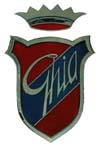



Imperial Home Page -> Literature -> Articles -> The Story of Ghia & Chrysler
|
« back
| |||
On the morning of November 9th. 1954, in the Belvedere Court of the Vatican Palace in Rome, a short ceremony took place: the Pope, His Holiness Pius XII, was presented with a new car. That day the Carrozzeria Ghia received what was perhaps the most coveted acknowledgment of the quality of its limousines. The Pope's Chrysler Imperial was not of course the first such important contract to be carried out by the firm belonging to Boano and Segre, but it was certainly the most prestigious one. Ghia had already built a car for Marshal Tito, ruler of Yugoslavia, on the same Chrysler Imperial chassis, and another for the White House. These were all important jobs which had created a certain market for Ghia.
Amongst Ghia's most faithful customers during those years there was also the Saudi royal family, for whom Ghia produced a parade limousine which included a very powerful radio receiver, something which was not very common at the time on board a car. In 1956, for the same royal customer, Ghia produced two Mercedes-Benz 300's, one an official open-top state car, and the other a saloon for palace service.
Nor should the car produced on the most noble chassis in the world, the Rolls-Royce Silver Wraith, be forgotten. It was shown at the 1954 Pincio Concours and appeared to be for King Farouk of Egypt, but Gian Paolo Boano is sure that the only Rolls-Royce produced by the company in that period was the one given to Ingrid Bergman by her husband, the film director Roberto Rossellini. (see several striking Imperial Phaetons here.) Ghia Crown Imperials When Luigi Segre managed to negotiate with Chrysler for the contract to transform of a small series of Imperials, the job was entrusted to Sartorelli almost as a matter of course. This was a very interesting contract for Ghia, because Chrysler was to send the Turin coachworks a number of production cars to be stripped down, have their chassis lengthened, and be completely rebuilt to be sold as a special series, the Ghia Crown Imperials. The first basic designs were American, produced by Virgil Exner, Cliff Voss and Bill Brownlie, the Chrysler Corporation design team, but in time the role passed to Sartorelli directly. The contract was renewed for nine years, from 1957 to 1965, and the whole time Sartorelli stayed at Ghia, until 1963, he was personally in charge. The Ghia Crown Imperials became parade limousines, used by the White House and Heads of State, both democrats and dictators, with no distinction between the good and the bad: Marshal Tito and General Franco, Queen Elizabeth II of England for her state visit to Canada, and the Arab monarchs. Of these limousines, Sergio Sartorelli remembers the one for the Emir of Kuwait for its originality and for the complexity and richness of the work carried out. The Chrysler Imperials There is no doubt that the most important contract Chrysler ever gave to Ghia was the one for a small production series of the prestigious Imperial. The Americans had decided to use Ghia's production skills on a luxury model to compete with Cadillac, at the time practically unchallenged in the top band of the American market, without having to assume the prohibitive costs of tooling up. The first contract was for the delivery of twenty- five Imperials between November 1956 and May 1957. The designs were all by Exner, helped by Bill Brownlie and Cliff Voss. The man responsible for coordination between Ghia and Chrysler was Dave Cohoe, and Paul Farago, who moved to Turin for the duration, was contract supervisor. Unlike similar ones which have been stipulated between other firms recently, the contract worked perfectly. The Chrysler chassis were shipped from the United States by sea, with an unfinished 2-door hard-top body, without doors, windows or seats. The components were shipped separately: windows, doors, air-conditioning plant and even the paint. At Ghia the car was cut and stretched with base and side panels built by Ghia; the ear was then finished by hand, painted, assembled and shipped back to the United States. The contract lasted from 1957 to 1965, and in that time one hundred and thirty-two Chrysler Imperial Limousines were built, of the different models which were updated each year by the American stylists as was customary.
| |||
| « back Page 5 |
This page was last updated 3 January, 2004. Send us your feedback, and come join the Imperial Mailing List - Online Car Club